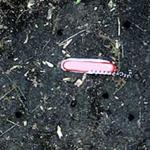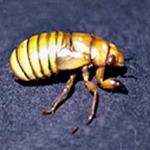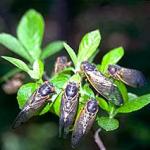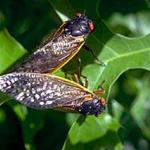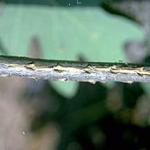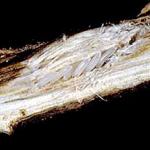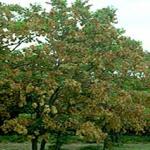Periodical Cicada
Order: Homoptera
Family: Cicadidae
Magicicada spp. (Magicicada septendecim)
Overview
Periodical cicadas were known to the native peoples of North America for centuries before Europeans arrived, but first recorded by European settlers in 1634. These insects are a wonder of nature, and should be respected and studied with awe; however, for a short time, they may feel like "pests" to some. Their main hosts are oak species and they emerge in large numbers in their broods which occur every 13-17 years, depending on the cicada species. The damage includes girdling of smaller saplings and twigs, which can be detrimental to the tree the cicada is ovipositing (laying its eggs) in. Management of periodical cicadas is rarely warranted, with the exception of protecting newly installed, young trees (or electing to delay planting until the year following expected brood emergence). Mature, well established trees typically tolerate periodical cicada activity.
2025 is a periodical cicada emergence year in Massachusetts! Please take photos and share your observations here on MDAR's iNaturalist Mass Cicadas: Brood XIV project! UMass Extension also hopes that you will join us for a virtual conference to learn more about periodical cicada's on February 5th! To register and join, please visit the events listing.
Host Plants
The periodical cicada has multiple hosts, but has a high preference for oak (Quercus spp.). They can also be found feeding on the roots of apple (Malus spp.), ash (Fraxinus spp.), birch (Betula spp.), black locust (Robinia pseudoacacia), dogwood (Cornus spp.), hawthorn (Crataegus spp.), hickory (Carya spp.), and maple (Acer spp.) trees.
Identification/Life Cycle
Periodical cicada species emerge every 13 to 17 years, depending upon the species. 17-year cicada species, such as those representing Brood X, include Magicicada septendecim, M. cassini, and M. septendecula. 13-year cicada species include Magicicada tredecim, M. neotredecim, M. tredecassini, and M. tredecula. Some cicadas emerge later than the majority of the brood, and may be found the year after a very large emergence in an area - however, these are typically eaten very quickly by predators. For parts of Massachusetts, historically, Brood XIV (Roman numeral 14) is the one that we need to watch, which is on track to emerge again in 2025. (Brood XIV is regionally distributed across KY, GA, IN, MA, MD, NC, NJ, NY, OH, PA, TN, VA, and WV and was last active in 2008.) For a map of where periodical cicadas exist, visit: https://cicadas.uconn.edu/broods/ . In Massachusetts, we expect that Magicicada septendecim is the primary species present.
The immature stages of these insects live on the roots of trees and shrubs, growing very slowly. In the case of 17-year cicadas (such as Brood X which was recently active in 2021), in the 17th year of their life they will emerge from the soil, usually in late-May to early-June. This may begin when soil temperatures at a depth of 7-8 inches reach approximately 64°F (Heath, 1968). As they emerge, they can climb trees, buildings, and all other manner of upright structures. They shed their nymphal skins (many of which remain visible to observers, stuck to these objects) and adults move to the trees. Adults will conduct a bit of feeding, and males make their well-known “buzzing” sound to attract females to mate (only males sing). Females will then use their ovipositor (egg-laying structure) to insert their eggs into the twigs of trees and shrubs (laying up to 600 eggs). Six to ten weeks later, those eggs will hatch, and nymphs will move to the ground where they will dig into the soil and begin feeding on host plant roots. After that time, their underground stages will go largely unnoticed until the next adult emergence event.
Damage
Periodical cicadas cause injury to a wide variety of deciduous trees and shrubs, but oaks are primary hosts. Females cause damage when they lay a series of small groups of eggs (inserting them into twigs). Small branches or twigs may be girdled or killed by this process. The damage may also predispose the impacted branches to breakage and allow for easy-access by pathogens. Adults feed on the fluids they extract from twigs, and the nymphs feed in a similar manner on the roots of trees. Injury as a result of this feeding is considered to be minor. Adult periodical cicadas do indeed feed, contrary to historical popular belief. While the feeding is minor, adults do feed on plant sap from their woody hosts (Hepler et al, 2023).
Broods of periodical cicada adults have synchronized emergence events every 13 or 17 years. These events can be loud and very noticeable to the public, although some periodical cicada species are quieter than others. Many people incorrectly categorize periodical cicadas with Biblical locusts. An important thing to remember about periodical cicadas is that they are native to North America and have evolved with our forests. Some research suggests that they are natural pruners of trees, their oviposition damage actually leading to fuller canopies by removing branch tips. When they die, the adult cadavers return nutrients to the soil. Mammals and birds eat them. Periodical cicadas often do not seriously damage their hosts, and are present so infrequently, and co-evolved with our forests, that management is not necessary.
Management Strategies:
Monitoring these insects usually occurs through watching the brood emerge from soil and crawl onto upright structures to molt. The next brood set to emerge in Massachusetts is in May 2025. Periodical cicada adults are managed mechanically through netting newly planted trees during an emergence year. Natural enemies of the periodical cicada exist, such as predators, but they may be oversaturated by the size of the brood(s) when it emerges, so a combination of management strategies may be most effective if young or newly planted host plants are in the area. Chemical management options exist, but are typically not necessary or effective. Under limited circumstances, chemical management options to protect young trees in the area of a periodical cicada emergence are available. Chemical management in locations where periodical cicadas do not exist is completely unnecessary.
Cultural/Mechanical Management:
Mesh netting (no larger than 1/2 inch openings) is a good way to protect newly planted, smaller trees during a periodical cicada emergence year in a geographic location where they are expected. This is only necessary if it is certain that the planting is in an area, during a year, that is expecting emergence. Netting needs to be placed on trees prior to cicada emergence, and kept on them for the 4-6 weeks of expected cicada activity. If possible, avoid transplanting trees in the fall and spring the year prior in areas where a periodical cicada emergence is expected. Also wait to prune trees where females are expected to oviposit (lay their eggs) until after the emergence has occurred. Orchards may need to take special precautions to protect their trees as well, particularly apples.
Biological Control/Natural Enemies:
A wide variety of predators will take advantage of the periodical cicada feast when it becomes available. However, predators are often oversaturated (there are not enough predators to eat all of the cicadas) during an emergence year, so the population is not reduced. This is the ultimate strategy of the cicadas, to emerge in force to avoid predation. Certain species of birds will feed on periodical cicadas (grackles, crows, etc.). In fact, certain species of birds may experience significant fluctuations in their populations during and post periodical cicada emergence (Koenig and Liebhold, 2005). Fish will even eat periodical cicadas that emerge near streams.
Periodical cicadas experience a fungal infection by Massospora cicadina, which has a life cycle such that adult cicadas can become infected by the fungus, followed by the next generation of cicada nymphs. The fungus impacts the adult periodical cicadas such that their behaviors become more attractive to other adults, increasing the likelihood of transmission of the fungus between individuals.
Chemical Management:
Chemical management of periodical cicadas may be difficult, and impractical, and is generally not recommended. Chemical management or physical barriers, such as netting, is usually only required on younger trees. However, there are products available containing the following active ingredients labeled for use against periodical cicadas in Massachusetts: bifenthrin (NL), carbaryl (L), cyfluthrin (NL), imidacloprid (L), lambda-cyhalothrin, pyrethrins + piperonyl butoxide (L) and zeta-cypermethrin (L).
Make insecticide applications after bloom to protect pollinators. Applications at times of the day and temperatures when pollinators are less likely to be active can also reduce the risk of impacting their populations.
Note: Beginning July 1, 2022, neonicotinoid insecticides are classified as state restricted use for use on tree and shrub insect pests in Massachusetts. For more information, visit the MA Department of Agricultural Resources Pesticide Program.
Read and follow all label instructions for safety and proper use. If this information contradicts language on the label, follow the most up-to-date instructions on the product label. Always confirm that the site you wish to treat and the pest you wish to manage are on the label before using any pesticide. Active ingredients labeled "L" indicate some products containing the active ingredient are labeled for landscape uses on trees or shrubs. Active ingredients labeled "N" indicate some products containing the active ingredient are labeled for use in nurseries. Always confirm allowable uses on product labels. This active ingredient list is based on what was registered for use in Massachusetts at the time of publication. This information changes rapidly and may not be up to date. If you are viewing this information from another state, check with your local Extension Service and State Pesticide Program for local uses and regulations. Active ingredient lists were last updated: September 27, 2024. To check current product registrations in Massachusetts, please visit the MA Department of Agricultural Resources Pesticide Product Registration page and click on "Search Pesticide Products Registered in Massachusetts - Kelly Solutions".
References
Heath, J. E. 1968. Thermal Synchronization of Emergence in Periodical “17-year” Cicadas (Homoptera, Cicadidae, Magicicada). Am. Midl. Nat. 80:440-448.
Hepler, J. R., W. R. Cooper, J. P. Cullum, C. Dardick, L. Dardick, L. J. Nixon, D. J. Pouchnik, M. J. Raupp, P. Shrewsbury, T. C. Leskey. 2023. Do adult Magicicada (Hemiptera: Cicadidae) feed? Historical perspectives and evidence from molecular gut content analysis. Journal of Insect Science, 23(5): 755-762.
Koenig, Walter D. and A. M. Liebhold. 2005. Effects of periodical cicada emergences on abundance and synchrony of avian populations. Ecology. 86(7): 1873-1882.
Periodical Cicada Information Pages - Broods - UCONN
UMass Extension’s Professional Insect & Mite Management Guide
Authors
Updated by Tawny Simisky and Paige Brown.
